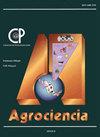RESPONSE OF Bemisia tabaci Genn TO THE ASSOCIATION TOMATO−AROMATIC PLANT
IF 0.5
4区 农林科学
Q4 AGRICULTURE, MULTIDISCIPLINARY
引用次数: 0
Abstract
The silverleaf whitefly (Bemisia tabaci) is the most harmful pest for vegetables in tropical zones. One alternative for its ecological management is the use of repellent aromatic plants. The hypothesis of this study is that the aromatic plants that diminish the attraction of B. tabaci to tomato have the capacity to prevent the infestation of this pest in the tomato crop when an intercropping system of tomato-aromatic plant is established. The objective of this study was to evaluate by means of the technique of olfactometry, the response of B. tabaci to the volatiles emitted by the crushed leaves of tomato and by the combination tomato + aromatic plant. The aromatic plants with highest activity in the olfactometry tests were intercropped in a tomato crop in the field. In the bioassays of olfactometry, a significant decrease was observed in the attraction of B. tabaci to crushed leaves of tomato + some aromatic plants compared with the attraction to tomato alone. The repellence indices (IR) showed that the aromatics Lavandula angustifolia Mill. (IR, 0.1), Petiveria alliacea L. (IR, 0.48), Petroselinum crispum Mill. (IR, 0.28) and Thymus vulgaris (IR, 0.5) had the greatest effect as repellent of adults. By integrating these aromatic species through intercropping in the tomato field crop, no significant difference was observed in the population density of eggs and adults of B. tabaci in the tomato foliage in regard to what was observed in the control (only tomato). The incidence and severity of viral symptoms did not decrease from the presence of the aromatic species intercropped in the tomato crop.烟粉虱对联合番茄-芳香植株的响应
在热带地区,银叶粉虱是对蔬菜危害最大的害虫。其生态管理的另一种选择是使用具有驱避性的芳香植物。本研究的假设是,在建立番茄-芳香植物间作系统的情况下,降低烟粉虱对番茄的吸引力的芳香植物具有防止烟粉虱侵染番茄作物的能力。采用嗅觉测定法研究了烟粉虱对番茄碎叶和番茄+芳香植物组合释放的挥发性物质的反应。对田间番茄作物间作了嗅觉试验中活性最高的芳香植物。在嗅觉生物测定中,烟粉虱对番茄碎叶+部分芳香植物的吸引力较单独对番茄的吸引力明显降低。驱避指数(IR)表明,香熏衣草的芳香成分。(IR, 0.1),韭菜菜(IR, 0.48),石竹(Petroselinum crispum Mill)。(IR, 0.28)和百里草(IR, 0.5)对成虫的驱避效果最好。在大田作物中间作这些芳香物种,番茄叶片中烟粉虱卵和成虫的种群密度与对照(仅番茄)无显著差异。在番茄作物间作芳香种后,病毒症状的发生率和严重程度并没有降低。
本文章由计算机程序翻译,如有差异,请以英文原文为准。
求助全文
约1分钟内获得全文
求助全文
来源期刊

Agrociencia
农林科学-农业综合
CiteScore
0.50
自引率
33.30%
发文量
51
审稿时长
18-36 weeks
期刊介绍:
AGROCIENCIA is a scientific journal created and sponsored by the Colegio de Postgraduados. Its main objective is the publication and diffusion of agricultural, animal and forestry sciences research results from mexican and foreign scientists. All contributions are peer reviewed. Starting in the year 2000, AGROCIENCIA became a bimonthly and fully bilingual journal (Spanish and English versions in the same issue). Since 2007 appears every month and a half (eight issues per year). In addition to the printed issues, the full content is available in electronic format.
 求助内容:
求助内容: 应助结果提醒方式:
应助结果提醒方式:


